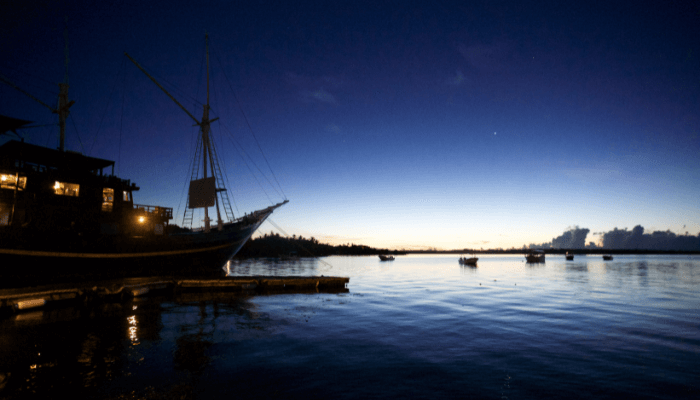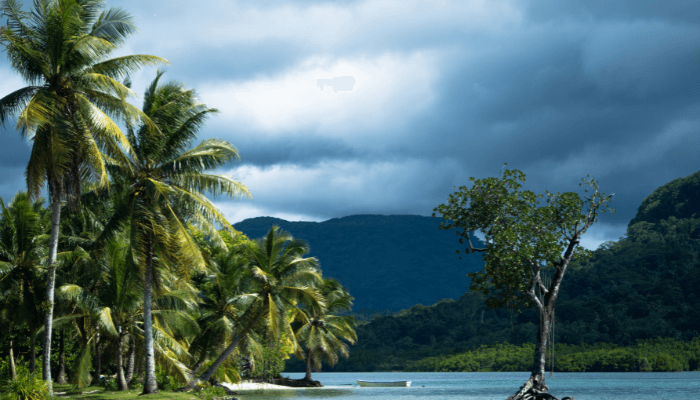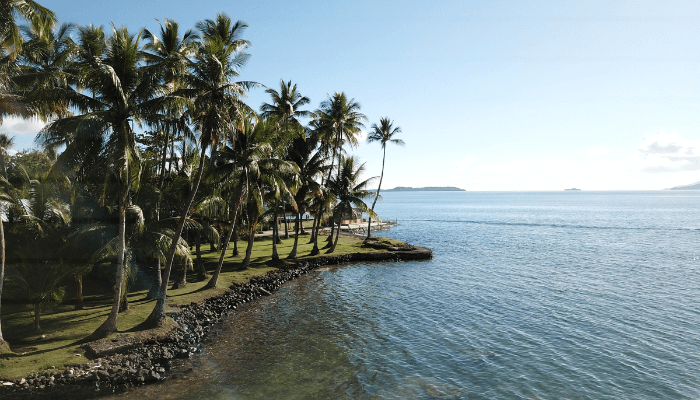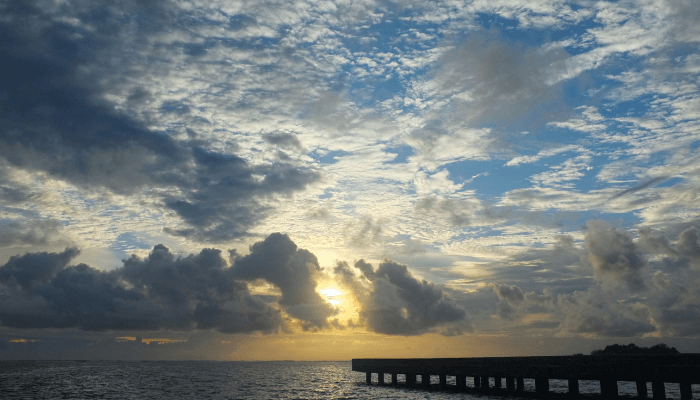4 Major Ports in Micronesia
The Federated States of Micronesia is an Island Nation in Micronesia, a subregion of Oceania. It has four states – Yap, Chuuk, Pohnpei and Kosrae. Together, they contain around 607 islands spanning 2700 km north of the equator with a combined area of 702 square kilometres. Near them lies Indonesia, Papua New Guinea, Marianas, Marshall Islands, Palau, Philippines, Japan and the Hawaiian Islands.
The main economic activities in Micronesia are subsistence farming and fishing. Principal crops are taro, bananas, coconuts, yam, sweet potatoes and cassava. Fishing for tuna is undertaken on a large scale, and facilities for storing these fish for export are available at the ports. Pigs and poultry are also raised for livelihood.
The islands do not have any mineral deposits worth commercial exploration except for high-quality phosphate. The islands are beautiful, with lagoons, coral reefs and marine biodiversity. Though there is a potential for developing a massive tourism industry, the remote location and lack of facilities and funds for infrastructural growth hinder progress.
The Federated States of Micronesia depend on international financial assistance, with the U.S being the primary source of revenue.
While Skipjack & bonito, frozen, Tuna (yellowfin), and Bigeye tunas are the major export items, imports consist of machines, meat, cars, processed and canned food, clothes, broadcasting equipment that comes from the U.S, Japan, China and South Korea.
1. Port of Yap/ Tomil Harbour
The Yap Colonia International Port, also known as the Tomil Harbour, lies on the southeastern side of Yap Island. It has a 264 m main dock for handling international cargo and two domestic docks.
The natural harbour was formed by the surrounding coastline and coral reefs that offer safe anchorage for large ships. It covers approximately 1.2 square kilometres and accommodates medium-sized vessels laden with cargo and fishing boats. The harbour depths range from 5 to 15 m, and the entrance channel is 150 m wide with a 7-10 m depth.
The port usually handles container freight apart from vehicles. Break Bulk is not moved unless it is an LCL container, bulk or bagged cargo received or handled internationally.
The port needs maintenance since the storage spaces and other structures are in poor condition. Terminal services are offered by a private company that deals with freight handling and stevedoring.
Usually, 8-10 vessels frequent the port each month. Containers are unloaded by the vessel’s gantry crane since no container cranes are available at the harbour. The port is not congested. However, a lack of sufficient handling equipment might leave it vulnerable at times when many ships are scheduled to arrive on the same day.

A RORO berth made of concrete lies at the port’s eastern end, which handles RORO ramp vessels with up to 500 MT loading capacity.
Imports include frozen meat, vegetables, timber, rice, electronics, canned food, and clothing, while fish, copra, and clothes make up the majority of exports.
Approximately 45,000 tonnes of cargo and 110 ships visit the port annually.
Ships with a maximum LOA of 183 m, a beam of 13 m and a draught of 11 m can access the port.
Port History
Indigenous Peoples of Pohnpei used the Tomil Harbour for fishing, trade and transport from 1000-1300 AD. It was explored by Europeans in the 18th century. In 1886, Germany established a protectorate over Pohnpeir; thus, a small pier in the harbour came up.
In 1994, it was the site of many naval wars and confrontations. During Operation Hailstone, the U.S tried to capture Pohnpei from the Japanese and several ships were attacked and subsequently sank in the harbour.
After the Second World War, the U.S gained control of Pohnpei through UN Trusteeship, and in the 1960s, a pier was built at the harbour to handle maritime trade. After the Federated States of Micronesia gained independence in 1986, Tomil Harbour developed into a major international port of the island country.
2. Pohnpei Harbour
The Port of Pohnpei is situated on the island of Pohnpei, the capital of the Federated States of Micronesia. It is operated by the Pohnpei Ports Authority and is overseen by the Department of Transportation Communication and Infrastructure.
The port is obstructed by several coral patches; however, it is well protected by a barrier reef. It is divided into four areas: an international cargo handling area, fishing docks, domestic docks and a marine surveillance area.
It mainly handles imported items for domestic consumption, which are containerised freight. There is an international dock and a fishing dock where tuna fishing vessels berth, with the maritime surveillance dock adjacent to the main dock area.
The domestic dock, south of the fishing dock, is the home base of 3 government-owned ships: MV Caroline Voyager, MV Micronesian Navigators and Lady Minto.

Around 3-4 ships carrying container freight visit the port each month. Matson and Kyowa Line offer scheduled services to the Pohnpei Port. It also receives bulk fuel vessels once every 90 days.
The port deals with 80 containers of freight a month. Containers must be unloaded by the ship’s gantry crane since no container cranes are available at the docks. Port equipment, though limited, is in good condition.
Port Equipment is owned and operated by a private operator, the Federated Shipping Company Ltd, also called FSCO. There are top loaders and large forklifts. Small forklifts are also available for moving palletised freight. There are no tug masters.
Pohnpei Port has two storage areas near the docks spanning 570 m2 and 1140 m2. It also has two transit warehouses for break bulk and a container storage yard. It also offers storage facilities for reefer containers; however, these are privately owned by fishing companies that use them for storing fish.
The outside storage area spanning 7500 m2 is used for general cargo and vehicles. Another 7000 m2 yard is used to keep break bulk.
3. Port of Chuuk/ Port of Weno
The Port of Chuuk, also called the Weno Port, lies on Moen Island in Micronesia. It is located in the Chuuk Lagoon, with Weno being the capital of Chuuk. It is operated through the State government Department of Transport and Public Works, which oversees the administration and port regulations.
The port has two main docks that handle international and domestic cargo. Access to the dock on Weno Island inside the Truk lagoon is through the outer reef. The two docks are 190 m and 185 m long. The biggest ship to ever arrive at the dock was 13,000 tonnes, though larger ships can anchor in the lagoon.
The Truk International Airport is close to the port, which saw 60 vessels in 2017, and roughly 5-6 vessels frequent it monthly. Usually, container freight is handled here apart from vehicles.
A private company, Transco handles terminal services and stevedoring. Pilot services are also available through a subcontracted Pilot.
Around 6 to 10 containers can be handled per hour and must be unloaded by gantry crane since no container cranes are available at the port.

Port History
Chuuk, earlier called Truk, has a long maritime history. It was the service port for the Japanese Fleet during the Second World War. It was heavily fortified, and the naval base at Truk was called the ‘Gibraltar of the Pacific’ by the Allied Forces. Some even called it Japan’s equivalent to the Pearl Harbour of America.
A huge chunk of Japan’s naval fleet was based at Truk during WWII, with the administrative centre being at Tonoas, which lay south of Weno. Truk Port has always had a strategic importance given its location.
It protected battleships, aircraft carriers, destroyers, cruisers, submarines and gunboats from enemy attack. Japan’s most powerful and heavily armoured battleships, Yamato and Musashi, were also stationed here for months in 1943.
In 1944, the capacity of Truk to function as a naval base was undermined after an air attack on the base in Operation Hailstone.
4. Port of Kosrae
This port is operated by the Kosrae Port Authority, responsible for the seaports and airports in Yap. The Kosrae Port has a single main dock for handling international freight inside a security perimeter.
Matson and Kyowa Shipping Lines serve the port via Guam for general cargo. Marianas Shipping Lines offers freight services to the tuna fishing industry.
The main port infrastructure is in fairly good condition, with a solid warehouse facility. Port equipment, though limited, is also in working condition. Kosrae Terminal Services and Stevedoring Company KTSSC is a private company that provides stevedoring and freight handling services at the port.
Around 3 to 5 ships, mostly carrying containerised goods and general cargo, visit the port monthly. The main dock is 170 m long and welcomes vessels up to 500 ft.
You might also like to read-
- 5 Major Ports In Cuba
- 10 Important Canals In The United States
- 10 Titanic Captain Facts You Might Not Know
- 15 Longest Straits In The World
- 10 Timor Sea Facts You Might Not Know
Disclaimer :
The information contained in this website is for general information purposes only. While we endeavour to keep the information up to date and correct, we make no representations or warranties of any kind, express or implied, about the completeness, accuracy, reliability, suitability or availability with respect to the website or the information, products, services, or related graphics contained on the website for any purpose. Any reliance you place on such information is therefore strictly at your own risk.
In no event will we be liable for any loss or damage including without limitation, indirect or consequential loss or damage, or any loss or damage whatsoever arising from loss of data or profits arising out of, or in connection with, the use of this website.
Do you have info to share with us ? Suggest a correction
Disclaimer :
The information contained in this website is for general information purposes only. While we endeavour to keep the information up to date and correct, we make no representations or warranties of any kind, express or implied, about the completeness, accuracy, reliability, suitability or availability with respect to the website or the information, products, services, or related graphics contained on the website for any purpose. Any reliance you place on such information is therefore strictly at your own risk.
In no event will we be liable for any loss or damage including without limitation, indirect or consequential loss or damage, or any loss or damage whatsoever arising from loss of data or profits arising out of, or in connection with, the use of this website.

About Author
Zahra is an alumna of Miranda House, University of Delhi. She is an avid writer, possessing immaculate research and editing skills. Author of several academic papers, she has also worked as a freelance writer, producing many technical, creative and marketing pieces. A true aesthete at heart, she loves books a little more than anything else.
Latest Maritime Knowledge Articles You Would Like:
Subscribe To Our Newsletters
By subscribing, you agree to our Privacy Policy and may receive occasional deal communications; you can unsubscribe anytime.
















